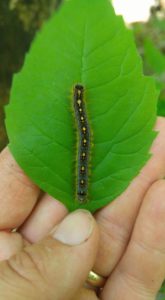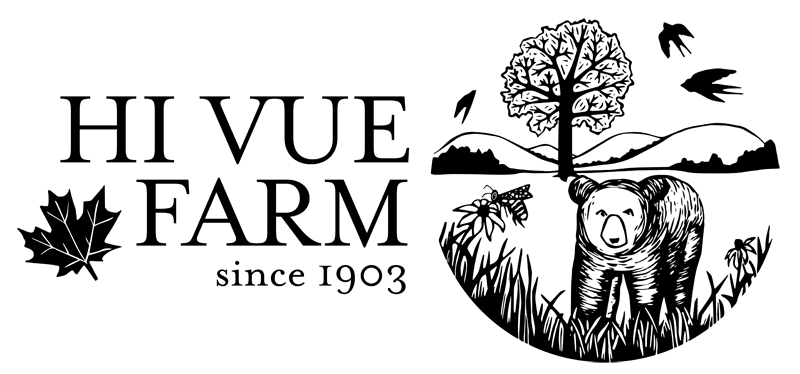We are a certified Bird Friendly Sugarbush with the Vermont Audubon Society. Our next project is a woodlot in the lower part of our property. We don’t tap this area because its heavily concentrated with softwoods. Most of it used to be pasture for cows when I was growing up. I would like to convert part of the area into agriculture – an apple orchard and possibly berries. Some of it may convert back to pasture as well.
I have taken 5 acres and will be working on a “patch cut” this year. A patch cut is to increase the habitat for native bird species and migratory birds as well as mammals. We will be removing 90% of the trees that are on this 5 acre piece. I am selectively choosing the trees that I want to keep – no most of them are NOT maple in this case! I have chosen several apple trees, a nice stand of white birch and another stand of old spruce. I’ve randomly picked a few younger trees – a cherry or two, but sometimes I’ve picked some huge gnarly old mishaped trees just because they spoke to me. I like trees with character.
In addition to those I also will leave some of the trees that are already dead and fallen and several trees that are either already dead or mostly dead but still standing – bugs love these trees which in turn means birds love them. Most of the trees that are cut will be used to heat my house next year. The branches and leftovers will be thrown in piles to create natural hiding and nesting places for the birds and creatures like bunny rabbits.
The point of cutting such a high percentage of trees is to encourage the undergrowth to flourish – this will be grasses that create seeds and berries to grow to feed the birds. Overall the hope is the patch cut will see an increase in the number and variety of birds in the area.
The woodlots program that created this patch cut idea also ties back into the Cold Hollow to Canada program that wants to create wildlife corridors. We are a tiny piece of the largest temperate forest in the world and are trying to help do our small piece to this big puzzle.
#birdfriendlymaple #coldhollowtocanada #audubon
The Mole Family
There are many great story tellers in the family – I am not one of them. I can remember about 3 jokes – this is one of them and the last one shared with Grampa Hue – the master storyteller. April was here and signs of spring were finally showing. The mole family was just…
Resolutions18
It’s that time of year again – we all have lots of good intentions but within a couple of months we slide back into old habits. I am as guilty as the next person. I’ve always been someone that loves lists – long term, seasonal, weekly, daily. Sometimes they worked mostly they made me frustrated.
As I think about the changes I want to make this year, I am also reflecting on what my goals were last year and how I did on those. Running – yeah not so much this year, which is frustrating so I am setting up new running goals this year. My big ambition is to do a 10 miler – my realistic goal is to do a 10k. That is achievable – 2 years ago after I committed to the Dandelion Run in May. I spent the money on the entry fee and didn’t want to waste my money, therefore I made a habit of running after I finished work and before I came home. I have a love/hate feel for running – hate it while I’m on the 1st and 3rd mile ( they always seem to be the worst). Love it when I’m done and the next several days after because I still feel good. I learned that if I did it before coming home or as soon as I got home it happened. If I came home, checked my email, made a few posts or basically became distracted by the million and one things that always need my attention IT DIDN’T HAPPEN. I let this happen this whole last year. I can see the why now I just need to fix it. We’ll see how my training goes next summer if I make the 10 mile run in the fall.
Of course being me and always trying to put a lot on my plate I can’t just be happy with one thing soooo…….even though I walk a lot a lot at work but it doesn’t count as exercise so I also am “resolving” to add more then just running – I want to try Yoga for the first time, I would like to actually go kayaking more then once this year and I want to go on at least 3 hikes (other then working in my own sugarwoods).
This last year I didn’t have any goals for exercise and I wanted to concentrate on growing my website – this is where I cut myself some slack – I didn’t run much at all this last year and only 1 kayak trip and 2 days of hiking, but I definitely learned a lot about my website, marketing and creating products. Now this year I would like to find a little more balance. A few of my business resolutions include increasing Facebook and Instagram viewers – adding more video to show more of what we do! and bring 3 new products to my market. I have the ideas and recipes I want to use now I just need to finish the ideas with the right packaging and labeling.
The resolutions that I want to make but I know I won’t be as picture perfect as they are in my mind – the vegetable garden without weeds, the box beds moved and overflowing with herbs and flowers and the porch alive with plants! I probably won’t get the porch repainted either.
So there’s my type of resolutions – personal, business and dream world. I have made inprovements over the last year and achieved at least partial success on my 2017 resolutions, now to just keep the momentum going and help it along by adding back in some needed exercise / me time!
Cold Hollow to Canada Woodlots Program
We are very happy to tell you that in addition to being a Bird Friendly Maple Sugarbush, we also are part of the Richford Woodlots Program. The Richford Woodlots is one piece that makes up the Cold Hollow to Canada organization. So what does that mean?
The mission statement for Cold Hollow to Canada is:
Our vision is a healthy and intact forested landscape that supports a strong and sustainable local economy through stewardship, with permanent protection of core wildlife habitat and connectivity across the entire Northern Forest.
They’re goal is the permanent protection of 40% of the unfragmented Priority Forest Blocks by 2030.
What is Hi Vue Maples doing to help? We are working with our local Richford Woodlots group. These are some of the things we are doing;
- Wildlife habitat development (we have surveyed an area for a patch cut to benefit wildlife and birds -work to begin in 2017)
- Interior songbird habitat (we are Audubon Certified Maple Sugarbush)
- Best Management practices (BMP) for working lands (we just updated our current use land management plan)
- Water quality protection (we have had the initial engineer survey to improve several of our stream crossings – work to begin in 2018)
- Invasive species control (knock on wood – we don’t have any)
- Climate change resiliency (we’ll try our best!)
Learn more about these great programs at audubonvt.org and coldhollowtocanada.org. Follow us on Facebook, Instagram Twitter and sign up for our newsletter where I’ll keep you up to date on projects we have going and lots of pictures!

Forest Tent Catepillars, Defoliation and Brown Foliage
Forest tent catepillars have arrived – they will stay for a 3 year cycle – the hope is they move through the forest and don’t stay in one area. They cause damage to a Maple and other trees by eating the foliage during growing season.
The forest tent caterpillar (Malacosoma disstria Hubner) may be found throughout the United States and Canada wherever hardwoods grow. Their favored host are sugar maple and poplar ( also known as aspen) Regionwide outbreaks have occurred at intervals varying from 6 to 16 years in northern areas. I posted a video on our Facebook page that shows the significant leaf reduction that occurred in our sugarbush this spring. The forest tent catepillar is a native insect that has attracted attention since colonial times. What I am learning and trying to focus on is the fact that these are native insects and while in the short term (sometimes long term due to death of a tree) is that we should just leave nature alone. Yes the catepillars do damage but sometimes you have to look at the bigger picture.

Forest Tent Catepillar
Catepillars came and ate the leaves. The leaves grew back but with a smaller leaf which created a thinner tree canopy. We have had 2 very wet years followed by a dry year. This year the foliage looks very dull and brown – even the conifers. That brown is caused by the excessive amount of seeds that the trees are bearing this year. Those seeds have and will be dropping to the forest floor to regenerate. Back to the catepillars that ate the leaves – less leaves equals more sunlight reaching through the canopy. More light helps theses seedlings establish which long term starts a whole new generation of new trees.
We do not expect to see a reduction in maple syrup production due to forest tent catepillars. I mentioned before that they can cause the death of a tree but usually that tree already has damage of some sort and does not deal well with any added stress. Tapping maple trees does add stress to the tree but we do not overtap (using too many taps per tree) or tap trees that are too small in diameter (a minimum of 12 inches). We also use what is called a health spout which has a smaller entry point for the tree.


